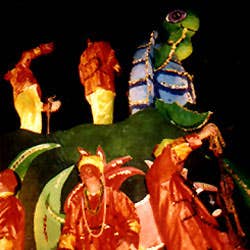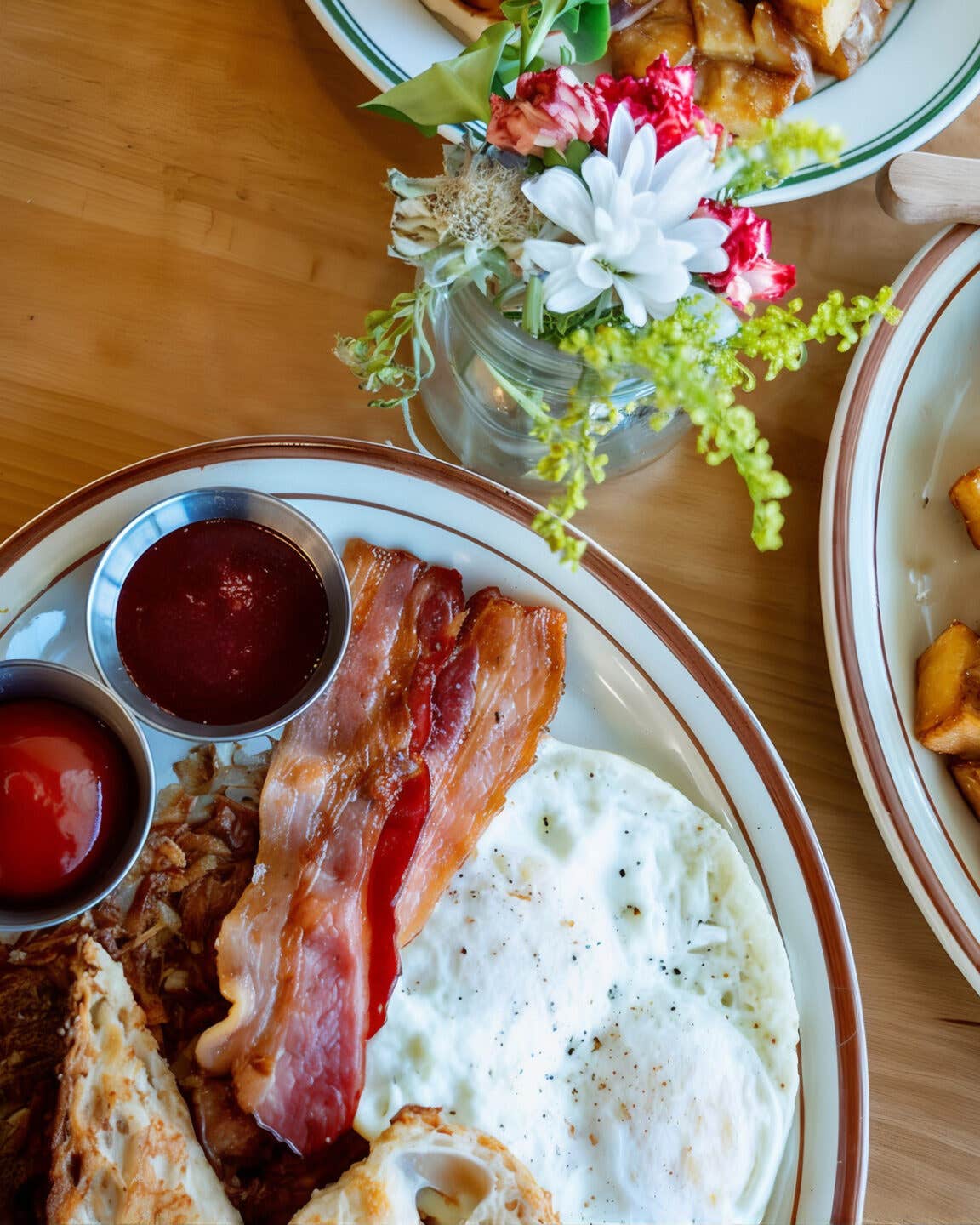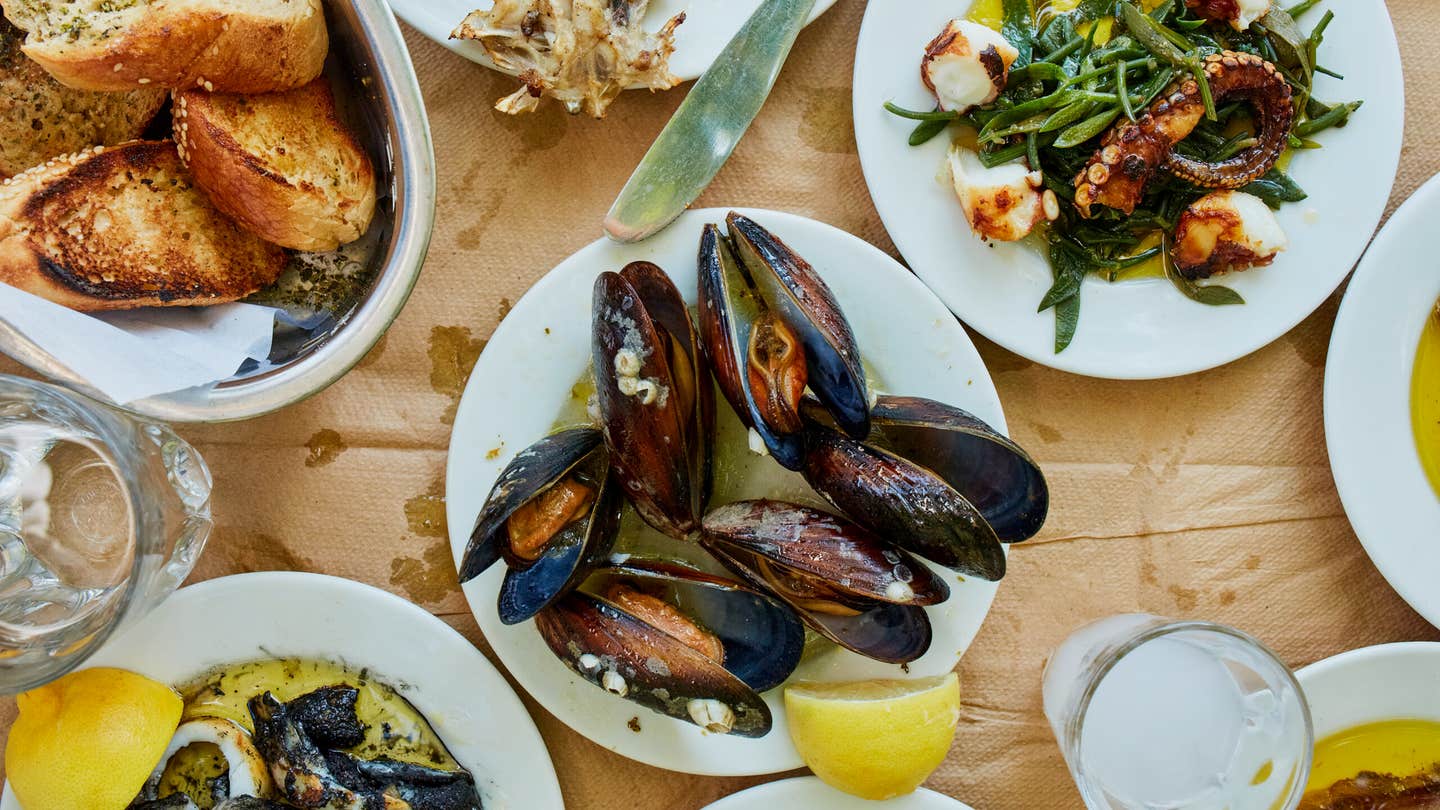
Mother of Mystics
New Orleans made it famous, but Mardi Gras as we know it began with the secret Carnival societies of Mobile, Alabama.
"To the citizens of this magnificent city, His Highness, Emperor of the Isle of Joy, commands that from this time until three days hence, no productive activity is to be attempted … May each person be consumed with the pursuit of merriment and joviality." Well, I'm all for that, I think to myself.
The speaker, addressing a dimly lit hall filled with several hundred folks decked out in ball gowns and tuxedos, is Frederick G. Helmsing Jr., Royal Orator for King Felix III—otherwise known as Joseph Guy Helmsing, Frederick's brother—monarch of the last Mardi Gras of the 20th century in Mobile, Alabama. Some people think New Orleans is the only city in America that knows how to throw a pre-Lenten carnival, but Mobile (that's "moh-BEEL," incidentally, founded in 1702 as the first capital of French Louisiana) has been mounting one of its own for nearly 300 years.
Mobilians like to boast, in fact, that they invented Mardi Gras as we know it—with its secret (or mystic) societies organizing extravagant balls and parades with floats and costumes. This might well be true, but the story is complicated: On New Year's Eve, 1830, a drunken cotton broker strode down Royal Street shaking a cowbell-festooned rake and attracting a small crowd—which he dubbed "the Cowbellion de Rakin Society." He then formed a regular club that marched—along with wagon-drawn tableaux (the first "floats")—on subsequent New Year's Eves, concluding its celebrations with masked balls. Other similar groups, cultivating secrecy and mystical trappings, imitated them.
Migrating Cowbellions had exported Mobile-style societies to New Orleans by 1857, where they were incorporated into Mardi Gras celebrations. Then, in 1866, back in Mobile, a Confederate veteran named Joe Cain, hoping to revive his war-torn town's joie de vivre, paraded through the streets on Fat Tuesday dressed as a famous undefeated Chickasaw chief. Cain set a precedent, and two years later the Order of Myths—still in existence today—began marching on Mardi Gras; other societies followed suit.
Our family lived in Mobile, a balmy, gracious city near the Gulf of Mexico, in the 1970s, and my brothers and I immersed ourselves in neighborhood and school activities. But we could never fully participate in Mardi Gras. We could watch the parades, but we couldn't be in them—at least not the best, most glittering ones—and we couldn't go to the balls after those parades, either; only old Mobile families were invited—people whose grandmothers, as the old saying goes, were conceived under an azalea on Government Street.
I've been to New Orleans's Mardi Gras as an adult, and have had more than my fair share of fun. (I've always gone home with lots of bags—some full of beads, others under my eyes.) But for years I extolled the virtues of Mobile's Mardi Gras, maintaining that it was smaller, cleaner, safer, and more family-friendly. Finally, in the spring of 1999, I decided to revisit the Mardi Gras of my youth to see how accurate my memories were. On my list: lots of parades, dancing, and drinking, and lots of good food. When it comes to cuisine, Mobile falls within Louisiana's sphere of influence—gumbo and étouffée appear on many menus—but it belongs to the Deep South, too, serving up fare like grits, fried green tomatoes, and fried chicken, and it is famous for its quail, shrimp, fish, and crab. As for the balls and parties, though several are now open to all, I wanted to explore the world of Mobile's exclusive secret societies, the ones you practically had to be born into. My key to that small, close-knit kingdom was Ann Doody Webb, a good friend and third-generation Mobilian, who got me invited to a slew of society affairs. I was set.
I hit town the Saturday before Fat Tuesday itself and head straight to 14 South, one of my favorite local restaurants. When I arrive, owner Cortlandt Inge—a tall, 30-something guy who's a perfect combination of smart-ass and sweetheart, and whose family goes back several generations in this town—is deep in shrimp, cooking some 500 pounds of it for a big mystic-society party. I grab a table and order fried crab claws, a Mobile classic. "I swore to myself in cooking school that I'd never have a deep fryer," Inge tells me, grinning wryly. "But you can't have a restaurant in Mobile without fried crab claws. People just won't come." The pinkie-size claws, from Gulf Coast blue crab, are just as they should be—plump and crisp. Then I have crab cakes with sherry cream sauce and crab corn salsa, and, to finish, bread pudding drenched in whiskey cashew-pecan sauce. As I'm leaving, a call comes in for Inge—one of his cooks. "Sick?!" Inge says under his breath. He cocks an eyebrow at me. "Sounds like someone had a little too much Mardi Gras last night."
Driving into downtown Mobile after lunch, I pass empty storefronts and dilapidated buildings, a legacy of the 1960s and '70s, when Mobilians deserted the city's heart for new suburbs to the west. Life has been trickling back into the area, though, encouraged by the construction of new civic buildings—like the waterfront convention center, where, that night, I witness the coronation of 22-year-old Emily Hayden Luce, Mobile's 1999 Mardi Gras Queen.
As an orchestra plays Dixieland tunes, the room swells with local society come for a night of pageantry, Mobile-style—a tradition that dates back to 1872, when both Mobile and New Orleans, inspired by the visit of Russian Grand Duke Alexis Romanov to New Orleans, appointed rulers for Mardi Gras. And what pageantry this is: A trumpet blares and in sweeps the court—knights in pantaloons and feathered hats; King Felix, wearing his rhinestone crown and an 18-foot silver lamé train; then the ladies of the court (the season's debutantes) in long white dresses, gloves, and heavily embroidered trains that look like they weigh more than the girls themselves (and that can cost more than $5,000 apiece). Finally the queen emerges, shimmering with rhinestones and gold thread. With much ado, Felix crowns her, and his orator proclaims his edict: party, party, party! And party these kids will, nearly nonstop. Tonight alone, the court—all 35 of them, with friends and family—will head backstage for the King's Supper. I sneak a peek at the table. Set (and paid for) by the king's family, it's laden with opulent sterling and crystal, gifts on every chair. Events like these, I realize, are backdrops for an old dance—the bonding between families; the passing of power from one generation to the next.
I start my Sunday at Loretta's, a restaurant whose silver-and-purple decor seems more South Beach than southern Alabama. Owners Christopher Hunter and his wife, Lori, lived for years in New York, but Christopher is old Mobile. (His mother, Gertrude, was Mardi Gras Queen in 1949, her mother in 1904.) Lori, a frank, sassy woman with a wide smile, gives me the scoop on what happens during Mardi Gras: lots of drinking, done with grace. As if on cue, a bloody mary appears, with a garnish so big it looks like a relish tray—and a few sips turn me into the laid-back southern girl I once was. But it's the plate of creamy grits topped with shrimp and bacon that really takes me back.
It's a five-minute walk from Loretta's to an afternoon Mardi Gras block party thrown by the Order of Myths (known by its acronym, OOM—or, in Mobilian, "Double Oh Eeyems"), the oldest mystic society in Mobile and still run only by men. Wives and daughters in pastel suits and hats are out in front, kissing each other's cheeks. "Hay, huney. How ya feelin' this mornin'?" they coo. I spot Ann Webb, my entrée to this event. She comes over, gives me a quick hug and a "Hay, Aay-uhn," and we make our way in, flashing our invitations.
Tantalized by the savory smoke filling the air, I snake through the crowd to a tent where grills are loaded with lamb chops, beef tenderloins, and sausages. The lamb chops are so succulent that the juices dribble down my chin. Across the street is another grill, full of oysters on the half shell, and everyone's stabbing forks into them while they're still over the coals. Wherever I turn, I'm being introduced to that cousin or this aunt; the queen has scads of relatives here, as does Cortlandt Inge, who's present, too, with his 500 pounds of shrimp piled on a massive ice sculpture. Drinking may pervade Mardi Gras, but great food and family is what truly keeps this tradition going.
I'm missing one crucial part of Mardi Gras, though: beads around my neck. Without those bright plastic garlands, thrown from every float and scooped up by every man, woman, and child to wear throughout the festivities, I feel like an outsider. So I head to Government Street downtown, where the Joe Cain procession, the only one that includes members of the public, is in full swing. I start to flail my arms as if I'm on fire. Someone takes pity on me and lobs a few beautiful long strings of purple, green, and gold beads my way. Neck draped, I no longer look like the new girl in town.
Later, over on Dauphin Street, I stop by Wintzell's Oyster House, home of oysters "fried, stewed, and nude," and in business since 1938. It's an eccentric place, walls hung with thousands of plaques painted with groan-provoking puns. I opt for a quintessential Mobile dish, West Indies salad—a mix of marinated crabmeat and onions, created in 1947 by one Bill Bayley at his Bayley's Steakhouse outside Mobile. (Bayley, who died in 1997, also invented fried crab claws.) And even though I haven't eaten this stuff since I was 8, I find myself automatically heaping forkfuls of West Indies salad onto saltines, just like I did when I was a girl.
Standing on a downtown sidewalk Monday evening, having spent the day visiting friends, I can hardly wait for the Infant Mystics procession to begin; there's nothing more thrilling to me than a nighttime parade. I've been invited to the society's ball—my very first Mardi Gras ball—afterwards, so I'm wearing a long lacy purple gown and pearls. Then the first float rounds the corner, a glowing spectacle in the darkness, dripping with beads and manned by men in satin and sequins. More floats roll by: a giant snowman backed by a pine forest; a flame-licked devil's head behind huge bottles of Tabasco—interspersed with marching bands and men on horseback, who toss beads and Moon Pies into the crowd. I try to stay cool, but by the time the third float sails by I'm deep in a tug-of-war over a pack of beads with a 70-year-old woman in a mink stole.
Happily laden with beads, I walk into the civic center, where a wintry scene of frosted trees glows onstage. The royal court glides in, and ladies in dresses of every imaginable style, from long and tight to cotton-candy-puffy, dart into fluorescent-lit rooms outside the hall to dig into fried chicken and boiled shrimp. Then they whip back inside for dancing to a Motown band. I'm reminded of something Mobilians claim sets their Mardi Gras apart from New Orleans's (something New Orleanians, incidentally, say is no longer the case): I remember Robert Hunter, Chris Hunter's father, telling me, "In New Orleans, only society members and the Mardi Gras court can dance. At our balls, the entertainment is open to everyone. Food, drink, dancing, all of it. Here you're a true guest."
At last it's Fat Tuesday, the final day of Carnival. In Bienville Square, thousands of folks have set up camp—literally. Tents, folding chairs, barbecues, couches (yes, couches). T-shirts and tattoos. And music: a truck pumping out hip-hop, Lynyrd Skynyrd blasting from a boom box. The first parade is the Order of Athena, a women's society, whose main float displays the goddess in a flowing red cape. Then come the Knights of Revelry, the third oldest society in Mobile, and behind them the University of Alabama's Million Dollar Marching Band, a thrilling surge of tubas, trumpets, and crimson-and-white uniforms. Next are the king, queen, and knights of Mardi Gras, and then the raunchy Comic Cowboys, with their very own queen, a large man in drag wielding a toilet-plunger scepter. Then in rolls the day's largest procession: the 20-float Mammoth Parade, organized by the Mobile Area Mardi Gras Association, an African-American Carnival group that has orchestrated its own parades since 1938. (The group also elects its own Carnival royalty and stages an elaborate coronation and several balls.) By now it's dark, and the Order of Myths, its brightly lit floats illuminating the crowd, closes the day with its own parade—as it has for the past 132 years.
I need one last meal before I leave Mobile, and I know just where to go—Ruth's Chris Steak House. Yep, it's a national chain, but this one is indisputably Mobilian: Its menu includes West Indies salad and gumbo, and portraits of past Mardi Gras Kings hang on its walls. As I'm standing at the bar waiting for my table, a good-looking dark-haired guy on my left congratulates me on the masses of beads around my neck and introduces himself as Earle Long IV. After a few minutes of swapping personal histories, we figure out that Earle went to school with my brothers. "You're not Tim and Neil McCarthy's sister!" he exclaims. All of a sudden I feel like I belong, back here, in Mobile. I almost feel like kin.
Keep Reading
Continue to Next Story










